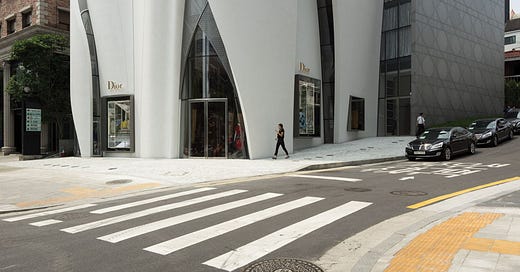This piece of travel/art writing must have been published shortly after my first extended visit to the South Korean capital, by which point I had already made several trips to North Korea. A year or so later, I would wind up doing a three-month residency in Seoul at the Museum of Modern and Contemporary Art, where I would undertake some quite valuable research for See You Again in Pyongyang. Re-reading it now fills me with a sense of tragic irony. With China’s fade, Seoul has begun its rise as the East Asian art capital du jour. There’s no way I or anyone else would have been able to detect that at the time.
Dansaekhwa might be enjoying its moment in the spotlight, but this past winter in Seoul, where it all began, the art-historical referent on everyone’s minds (and on every other billboard) was Nam June Paik, whose retrospective, occupying both spaces of Gallery Hyundai, opened in January. Although Paik left Seoul in 1950, at the age of 18, to escape the Korean War, he returned to the city several times to produce a number of memorable works and actions, including A Pas de Loup (Discreetly, 1990), a large and elaborate shamanistic performance that served as a funerary homage to Joseph Beuys. Documentation of the performance, as well as the objects Paik used, featured prominently in the show.
Shifting economies of attention are the nature of existence in the South Korean capital. The velocity of the city’s social life can be measured by the dizzying speed at which trends come and go: one month, a dozen new Korean-Mexican fusion restaurants sprout up; three weeks later, the crowd has moved on to southern US soul food, and so on. ‘Competitive’ is the adjective used over and over by Seoulites when asked to describe their society, and this applies to more than just climbing the academic or professional ladder. It’s also about being two or three steps ahead of the latest fads: an aspiration that suggests an underlying fear of being left behind, which, in its worst incarnation, can lead to an overwhelming pressure to conform. Many South Koreans I met admitted that their society is, after all, still governed by a deeply traditional and conservative value system, despite often appearing to be at least two decades ahead of the West in terms of its architecture, technology and infrastructure.
It was minus 30 degrees on the day I arrived in Seoul for my first visit, but I quickly warmed up after stuffing myself with fiery doses of kimchi and squirts of milky sweet makgeolli. My visit felt long overdue: multiple trips to the surrealscape of North Korea had instilled in me a lingering curiosity about the more developed and accessible side of the peninsula. I felt a bit guilty about betraying my sweet North Korean guides, from whom – despite widespread propaganda portraying South Korea as an illegal puppet state of the American imperialists – I had always detected a hint of disappointment when I told them I hadn’t been. My immediate observation: if North Korea seems perpetually stuck in the 1970s, South Korea is hyper-advanced in fields such as fashion and technology. With its spotlessly clean and efficient subway lines, the fastest Wi-Fi in the world – freely available virtually everywhere – and bold, 21st-century architecture (including GT Tower East, Boutique Monaco and Kring Kumho Culture Complex, to name but three of the most impressive structures), Seoul makes a city like New York look as though it’s living in the Dark Ages.
With the second largest metropolitan area in the world, Seoul is, unsurprisingly, also home to a massive quantity of museums, galleries and alternative exhibition spaces – I struggled to see even half of them during my week-long trip. Short-term visitors tend to concentrate on the galleries and museums scattered throughout the Insadong district, which is wedged between two icons of classical Korean architecture: the Joseon Dynasty Gyeongbokgung Palace and the traditional houses of Bukchon Hanok Village. One of the most touristy areas of the city, Insadong is a fusion of old and new, with high-end boutiques installed alongside antique markets, traditional tea houses and Buddhist temples. Besides Gallery Hyundai, the district is also home to the MMCA, which – to give an idea of its size – was hosting simultaneous solo exhibitions by Philippe Garrel, William Kentridge, Ahn Kyuchul and, my personal favourite, a collection of recently donated, large-scale abstract ink paintings by Suh Se-Ok.
Keep reading with a 7-day free trial
Subscribe to Travis Jeppesen to keep reading this post and get 7 days of free access to the full post archives.



